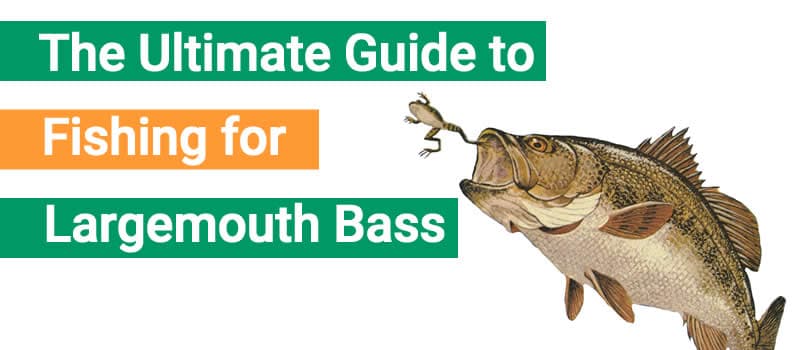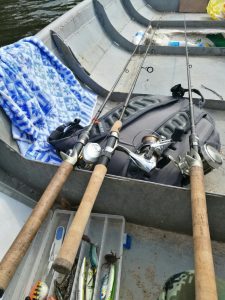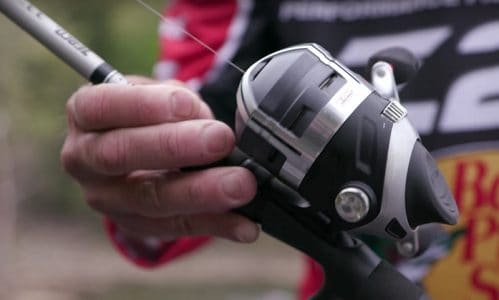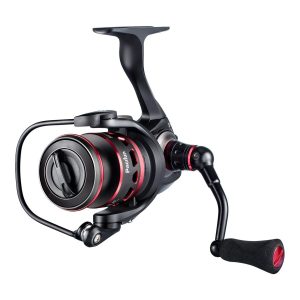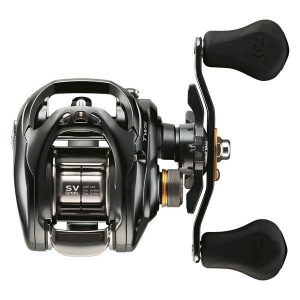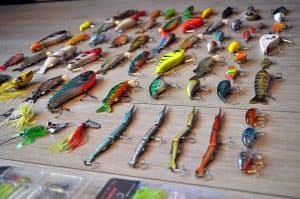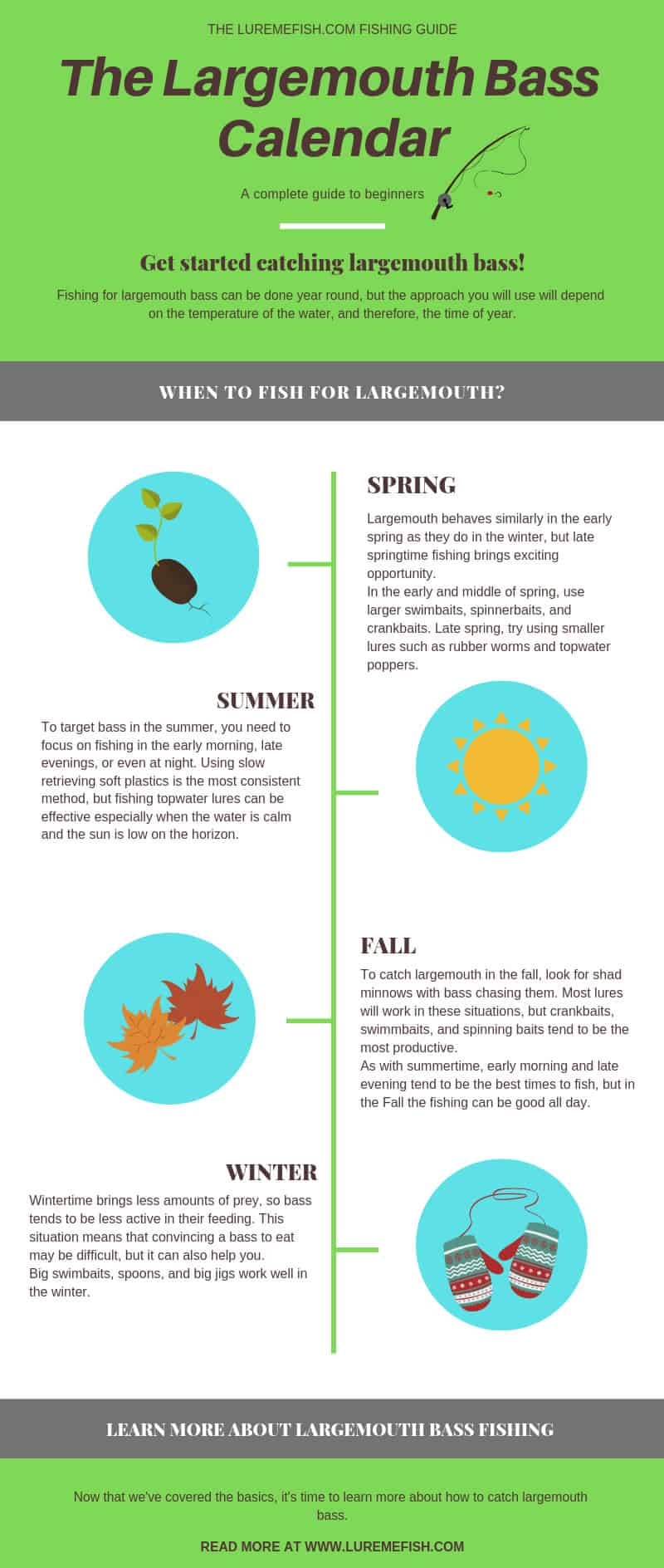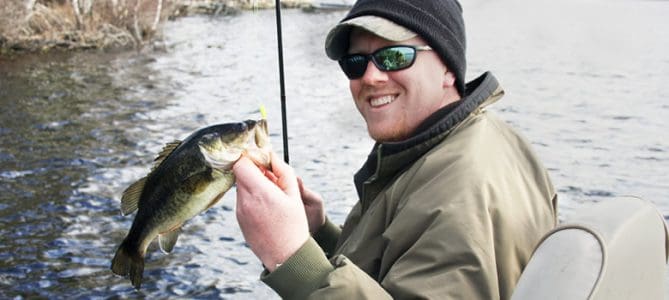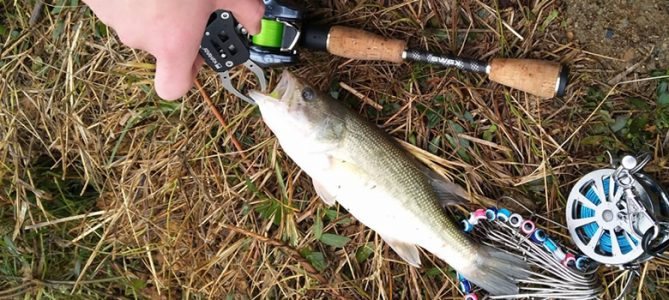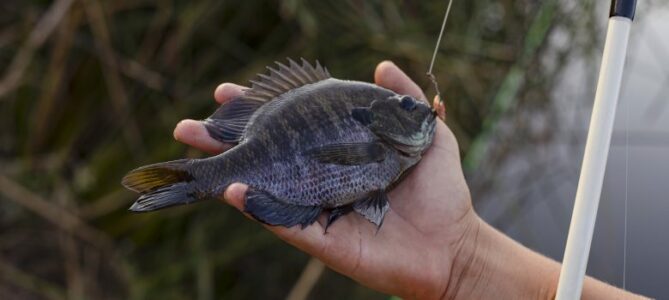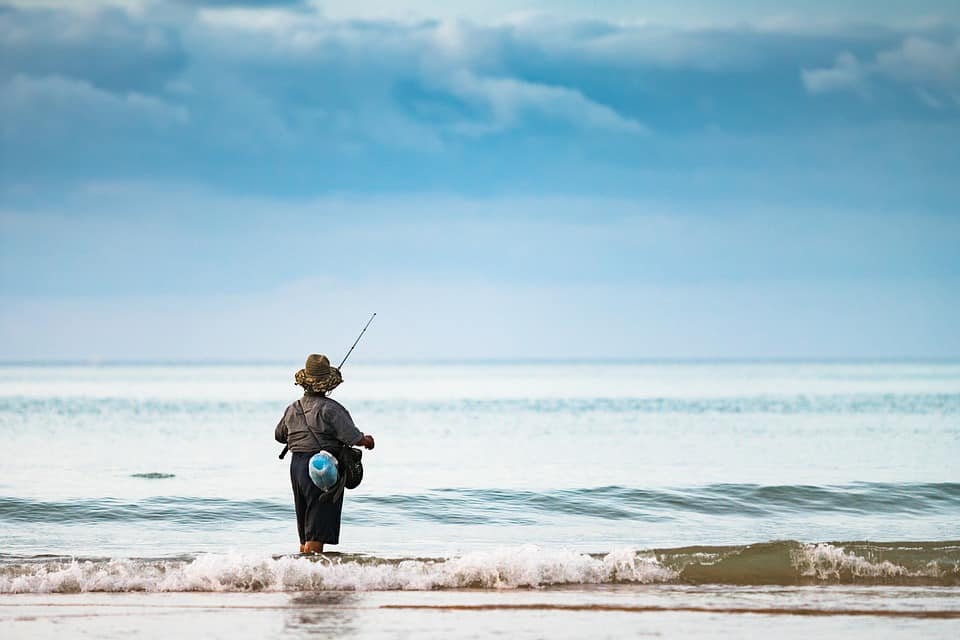If you buy via a link on this page, we may receive a commission, at no extra cost to you.Learn more
The largemouth bass is one of the most popular, if not the most popular, sport fish in the world, and with good reason.
I’ve fished all over the world.
I’ve fly-fished for bonefish and permit in Belize where crystal clear flats tantalize fishermen with opportunities. I’ve wrestled 200-pound tarpon in Southwest Florida while their comrades erupt on baitfish around me. And I’ve spent hundreds of hours standing in ice-cold mountain streams attempting to fool trout into eating hooks wrapped in animal hair.
But I always find myself coming back to the fish that started my love affair with fishing; the fish that can make my day as quickly as it can ruin it; the fish that isn’t the biggest, strongest, or prettiest, but that is to me the greatest- the largemouth bass.
It is a voracious, opportunistic feeder, that challenges even the most seasoned anglers with state of the art equipment and years of experience, but can still be caught by a toddler with a 3-foot pole.
I grew up fishing for largemouth bass with my dad in the lakes, rivers, and ponds of North Alabama, so it is the subject of my fondest fishing memories. But that doesn’t mean I’ve got these fish figured out.
In fact, the Largemouth Bass is the fish that prompted my familiarity with the phrase “that’s why they call it fishing not catching.”
But, I’m going to attempt to share some of the wisdom I’ve gathered for targeting these fish in an effort to help you do more catching and less fishing. We’ll talk about what you’ll need to fish for largemouth, and where and when to fish for them.
Without further ado, I give to you The Ultimate Guide to Fishing for Largemouth Bass (and a picture of my personal best largemouth).
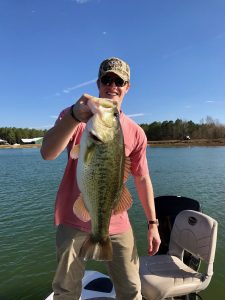
Overview
They go by numerous names, including the bigmouth bass, the lake bass, or even bayou bass. However, most names hint back to their most prominent feature: their largemouth, the opening of which extends far past their eye socket. Their popularity is likely due to their ubiquity; the bass has proven its ability to thrive in almost any freshwater environment.
Because of the popularity of bass fishing, countless methods have been devised for catching them. Many fishermen prefer using a live bait method for bass fishing, with crawfish, minnows, nightcrawlers, or even leeches being used as effective bait. However, the bass certainly does not require live bait. Countless artificial lures have also been developed. While each fisherman will certainly have a favorite to cite, various iterations of plugs, spinners, jigs, and plastic worms have all shown to be effective at attracting the fish.
Largemouth bass tend to avoid direct sunlight, so midday glare off the water can make bass fishing a challenge. Thus, most bass fishing takes place early in the morning or later at night. One of the key challenges of hooking a bass is the bass’s strong preference for being under cover. The bass will often hide under logs, overgrowth, or other submerged objects. Further, once hooked, they tends to have a particularly strong reaction. They often surface while thrashing violently to free themselves from the hook. In this process, it is easy for the line to become tangled in nearby debris, so efficiency is key when reeling in your catch.
Common Name: Largemouth Bass
Scientific Name: Micropterus Salmoides
Family: Centrarchidae
Identifying Characteristics: They are olive-green or greenish-gray, with numerous dark splotches converging into a horizontal stripe on each side of the fish. The jaw extends far back into the body of the fish, leading to a large and horizontal mouth opening.
Depth Range: 20-35 Feet.
Natural History: Originally, they were primarily localized to the Eastern United States. However, their extreme popularity as a sport fish – combined with their ability to adapt to numerous and varied environments – has led them to be exported and spread throughout the word.
Size limits:An adult will typically reach 18″ and weigh 12 pounds.
Largest Recorded:The largest example ever recorded weighed 22 pounds and was caught in Montgomery Lake, Georgia in 1932.
What do they eat?
Due to the extremely varied locations they inhabit, their diets tend to be equally diverse. Thus, the simple answer to “what do they eat?” is “whatever they can.” Their identifying feature – their large mouth – makes it possible for them to consume prey that is large in comparison to their own size.
In swampier areas, such as in the American South around Louisiana, bass will often have a more insect-based diet. This is due to the comparatively shallow and slow-moving water making it easier for the bass to surface and consume prey flying by. Thus, in these cases, the bass will often consume mosquitoes, flies, mayfly nymphs, or even larvae such as that of the blackfly.
In areas with deeper water or faster currents, the bass will often have a more aquatic diet. Thus, in rivers or turbulent lakes, bass will often consume smaller fish, mussels, or even tadpoles and frogs. But the general rule of thumb is that they will eat whatever it desires. While less common, bass have been observed to eat salamanders, turtles, or even mice. Their diet is truly as diverse as their location.
Not only is the diet of the bass unique, so too is its method of eating. They will generally lie in wait under a log or other cover and then lunge at its desired meal. Generally, they will not consume their prey immediately. Rather, once they have captured their target, they will their prey in their jaw until it stops moving. Only then will they finish the swallowing process.
Essential Gear
Fishing for largemouth bass can be as simple or as complex as you want it to be.
You can take your old cane-fishing pole down to a pond, hook a night crawler on, and catch a half dozen fish for supper.
Or you can spend $400 on a state of the art rod and reel, $50,000 on a 250 horsepower bass boat, and a few extra thousand on electronic fish finders, trolling motors, and power poles.
We’ll keep it simple here and just discuss the essential tackle you’ll need to get started: a rod, a reel, fishing line, lures, hooks, and weights.
Reel
Many people assume that you should first purchase a fishing rod before buying a reel, but it is actually the reel that determines the rod so that doesn’t work.
There are three types of reels that people use to catch bass: spinning reels, bait casting reels, and spincast reels. The type of reel you should get depends on personal preference, and level of experience. Here’s more information to help you decide.
Spincast Reels
A spincast reel is the easiest, simplest to use a type of fishing reel, and is, therefore, the type most commonly used by children and beginners. It looks something like this:
The reel has a button on the bottom that you press to release the line. When you want to cast, you press and hold the button, bring the rod back, quickly bring the rod forward, and release the button.
Spincast reels require minimal maintenance, cast fairly accurately, and usually don’t get tangled. However, these reels also must use a lightweight line that can break when hooking bigger fish, and the reel cannot cast as far as other types.
So, this reel may be a good choice when you just get started fishing for largemouth bass, but after you gain some experience you will want to switch to a different type of reel.
Spinning Reel
Spinning reels are a step above spincasters in terms of complexity and difficulty of use.
However, with experience in largemouth bass fishing, using a spinning reel becomes second nature. Also, spincasting reels offer distinct advantages over spincasters, so spinning reels are one of the most popular types of reels used by bass fishermen.
Spinning reels look like this:
Spinning reels don’t have a button you press to release the line. Instead, to release the line you lift that metal wire looking thing (called a bail) and lock it into its open position.
To cast with a spinning real, you lift the ball into the open position, hold the line against the rod with your finger, bring the rod back then quickly forward, and release the line with your finger.
When your lure hits the water and sinks to the appropriate depth, you close the bail and begin to reel in your line.
Spinning reels can hold more line and stronger line that spincasters. This means that spinning reels can cast further and can also be used to fight larger fish.
However, spinning reels are also more prone to line tangles, but these are usually easily fixed since the line is visible. Also, spinning reels tend to have a faster line retrieval rate, making slow presentations of lures more difficult.
Baitcasting Reel
The most common type of reel with experienced and professional largemouth bass fishermen is the baitcasting reel, which looks like this:
Baitcasting reels allow for more accurate casts than spinning and spincasting reels. This is because the line goes straight onto and out of the spool, instead of being twisted around like with spinning and spincasting reels.
Also, baitcasting reels can handle the heaviest lines, and large amounts, meaning casting distance won’t be a limiting factor.
However, the biggest perceived disadvantage of baitcasting reels is that they are much less intuitive to use, and therefore take more practice.
To cast a baitcasting reel, you press a button to release the line (similar to a spincasting reel), and you stop the line from running out by putting your thumb on the spool.
With your thumb still on the line, you bring the rod back, then quickly forwards again, releasing your thumb from the line. Right before your lure hits the water, you put your thumb back on the line to stop it from spinning.
It sounds simple, but the timing of the motions is imperative for an accurate cast, and if you don’t stop the line from free spinning before your lure hits the water your line will turn into a tangled mess.
Rod
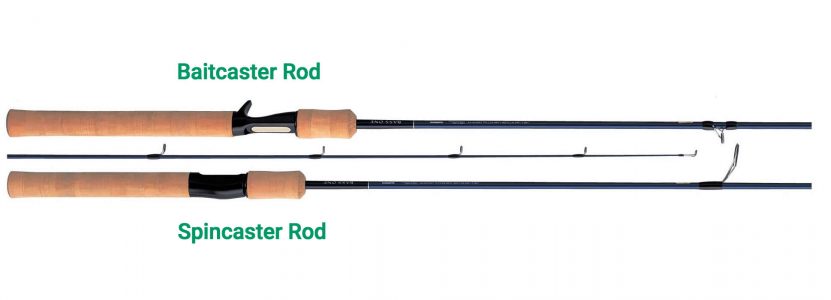
As mentioned earlier, the type of rod you should use depends on the type of reel you that you’re using. Spincasting reels and baitcasting reels generally use stiffer reels with smaller line guides. Spinning reels are best paired with more moderate action rods with larger line guides.
So, if you’re using a spincasting reel or a baitcasting reel, I recommend a 7-foot fast-action baitcaster rod. And if you’re using a spinning reel, I recommend a 7-foot medium action spin rod, but you could also get away with using something a little shorter.
Best Line for Largemouth Bass
As with the other tackle used for largemouth bass fishing, the type of line you will decide to use can be a complicated decision.
Specific types of line are more effective using certain types of lures, and factors such as water clarity and the size of the fish you may catch can also affect your decision.
So, we’ll go over the three types of line fishermen use to target largemouth bass, and you can decide what will be best for you.
Braided

Braided fishing line is the oldest type of line used for fishing. It is the strongest, most castable, and it has no “stretch.”
However, braided line is also the most visible to fish, and if you’re fishing for educated fish or in bright or Clearwater conditions, this can prove to be a problem. If you’re fishing at night, or in thick cover, this wont be an issue, though.
If you decide to target largemouth with braided line, try a 10-pound test for spinning rods and spincasters, and 35+ pound for baitcasters.
Fluorocarbon
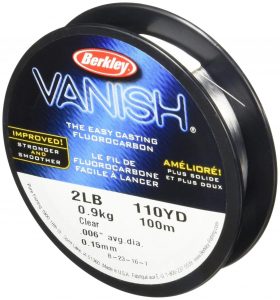
Fluorocarbon, or “fluoro” as the cool kids call it, is similar to the braided line as it has no stretch, but it is clear so it is less visible to the fish. This allows fishermen to present more realistic lures to largemouth, and (hypothetically) catch more fish.
Fluorocarbon is not without its disadvantages, though. Fluorocarbon line sinks, making it less ideal for floating lures. Also, the line tends to be less abrasion resistant, which can result in broken lines and lost fish, especially when fishing in thick cover.
If you choose fluorocarbon line to target largemouth bass, I recommend using 12-pound test for small and medium-sized lures. When using fluorocarbon with heavier lures, 15 to 20-pound test will be what you need.
Monofilament
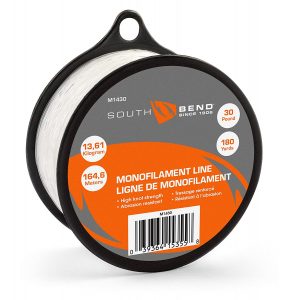
Monofilament line floats, is quite invisible to fish, and is castable. However, monofilament also stretches which can be an issue in certain situations.
Monofilament is the most popular type of line used to target largemouth, though, so using it is a safe bet. It’s perfect for floating lures, but also works for sinking lures and even live bait.
If you choose o use monofilament line to target Largemouth Bass, I recommend using line between 10 and 20-pound test, depending on the size of the fish you’re targeting.
Best Lures for Largemouth Bass
The most popular methods of targeting largemouth bass involve using artificial lures to catch bass. Basically, you deceive the fish into thinking it’s getting a meal when it’s actually getting a hook in its mouth.
Using artificial lures is the most popular method because it requires the most skill. Bass are smart fish that only get smarter when they see more fishermen, so fooling them into taking your lure takes practice and patience.
But it also takes the right lure, so that’s what we’re going to help you with today. Here are some of the most common types of lures used to target largemouth bass, and how you should fish them.
Swimbait
Swimbaits are soft plastic or hard bodied lures that are fished below the surface. They imitate baitfish, bluegill, other bass, trout, or whatever other types of prey that bass feed on.
Swimbaits are versatile and utilitarian, as they can be used in different conditions and throughout the year.
To fish with a swimbait, simply cast towards fishery areas and let the lure sink to the depth that the fish are feeding. Then, steadily retrieve the lure at a medium pace. If you feel a sharp tug on your line, firmly lift your rod up to set the hook.
Crankbait
Crankbaits are another staple bass fishing lure that also imitates baitfish and can be used year round.
They are firm plastic lures with a “bill” on the front that makes the lure sink lower into the water as you reel it in. Also, the lure’s design creates a wobble during the retrieve that emulates an injured fish, which attracts more bass.
To fish a crankbait, use deepwater lures in open water fishing with a medium to fast retrieve. When fishing a crankbait in shallower water, use a square-billed crankbait to avoid getting caught in weeds or other covers.
A fun part of fishing crankbaits is that when the bass hit them, they hit hard. Also, since the lure is covered in treble hooks, you probably won’t miss too many fish.
Jerkbait
Jerkbaits are a hard plastic lure that is typically used in colder weather. These baits float in the middle of the water column and imitate an injured minnow.
Jerkbaits are so named because you fish them by sharply “jerking” your rod as you retrieve your lure.
To fish a jerkbait for largemouth, cast to a fishy area and let the bait sinks to the middle of the water column. Then begin to retrieve your lure at a slow to medium pace, while adding the jerks. When you feel a tug, set the hook!
Rubber worm
The rubber worm is the go-to lure for fishing in warmer weather. This type of lure covers rubber minnow, worm, lizard, salamander, and crawfish imitations.
Fishing with these soft plastic lures can catch you fish in a variety of situations. Un-weighted rubber worms and lizards can be fished on the surface near thick vegetation for topwater bites.
Weighted plastic worms and crawfish imitations can be fished on the bottom for subtler takes.
No matter how you fish them, though, one thing to keep in mind when fishing with rubber worms is that you will be fishing slowly.
To use them, cast to your target and allow the lure to reach the depth your fishing, whether that is the surface, middle of the water column, or the bottom. Then, slowly retrieve your line. My grandfather always said, “if you think you’re fishing too slow, slow down.”
You can add some subtle action to the lure by raising or lowering your rod, but remember to keep it slow, and be aware of small tugs and nudges. Bass can take rubber worms with the most subtle of bites, but you need to be ready to set that hook hard.
Here’s a picture of a largemouth I caught with a rubber worm a couple years ago.
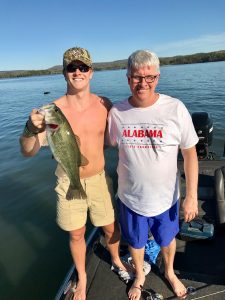
Jig
Jigs are the go-to year round largemouth bass lure. They can catch fish in the heat of summer or the dead of winter- in 40 feet of water, or in 4.
A jig is a weighted lure that imitates a crawfish or some other prey on the bottom of the water. It doesn’t really matter though, as jigs are used to entice bites from bass by appealing to the fish’s aggressive nature.
To fish a jig, cast the lure, let it sit on the bottom, and twitch it every so often while slowly retrieving your line. You will likely get a feel for what it feels like when your jig hits the bottom, but if you feel a different type of nudge, set the hook!
Live Bait
While the professionals choose to use lures to target largemouth bass for sport, live bait is extremely effective for catching bass both in number and in size. In fact, one of the biggest bass I’ve ever caught in my life was on live bait and it tipped the scales at almost 9 pounds, but that’s a story for a different day.
When using live bait for catching largemouth bass, you can get away with using many different options. Live minnows, crawfish, worms, or crickets are the most popular choices. Just be sure to check local laws and regulations on what you can use.
Where to fish for largemouth
Largemouth Bass are opportunistic feeders that don’t like to expend much energy on getting food- you won’t usually see a largemouth chasing prey too far.
Instead, largemouth like to ambush their prey and instead expend short bursts of energy with aggressive strikes. For bass fishermen, this gives us information on where to fish for bass.
Whether you’re fishing in a pond, lake, creek, or river, largemouth bass will tend to be hanging out around cover. That cover provides them a hiding spot from where they can ambush their prey.
Look for logs, trees in the water, grass, or boat docks. Anything that provides structures in the water that gives the bass somewhere to hide. A stupid phrase people use to remember this is “wood is good, rocks rock.”
If obvious structure like that is difficult to find where you’re fishing, try fishing points and corners in the shoreline. Or look for sudden depth changes that can be submerged creeks or ditches. These areas will also hold fish.
When to fish for largemouth
Fishing for largemouth bass can be done year round, but the approach you will use will depend on the temperature of the water, and therefore, the time of year.
Fishing for largemouth in the summer
Bass tend to slow down and become more lethargic when the water warms up, so fishing during the summertime can be difficult. However, some of the best days I’ve had on the water were during the summer.
To target bass in the summer, you need to focus on fishing in the early morning, late evenings, or even at night. Using slow retrieving soft plastics is the most consistent method, but fishing topwater lures can be effective especially when the water is calm and the sun is low on the horizon.
Fishing for largemouth in the fall
Some of the hottest largemouth bass fishing occurs every year during the fall.
As water temperatures go back toward the more optimal range for bass, they tend to be feeding more aggressively than during the summer. Combine this fact with the large number of shad minnows during this season, and you get bass feeding frenzies.
Also, as temperatures continue to cool, bass will search for warmer water near the shore, making them easier to find.
To catch largemouth in the fall, look for shad minnows with bass chasing them. Most lures will work in these situations, but crankbaits, swimmbaits, and spinning baits tend to be the most productive.
As with summertime, early morning and late evening tend to be the best times to fish, but in the Fall the fishing can be good all day.
Fishing for largemouth in the winter
Bass are cold-blooded animals. That means their internal temperature matches that of its surroundings.
Cold largemouth, like hot largemouth, is slow largemouth. Also, wintertime brings less amounts of prey, so bass tends to be less active in their feeding. This situation means that convincing a bass to eat may be difficult, but it can also help you.
Since bass are opportunistic feeders, and since the wintertime temperatures make them slower, they want to get the most out of their winter feedings. That means to target winter largemouth you want to use a slow presentation of a large meal.
Big swimbaits, spoons, and big jigs work well in the winter, especially when you can find the fish, as you can see from the picture below.
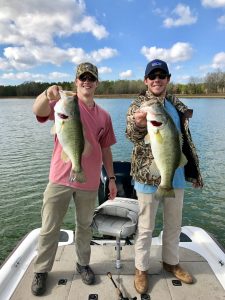
Fishing for largemouth in the spring
Largemouth behaves similarly in the early spring as they do in the winter, but late springtime fishing brings exciting opportunity.
As the bass exit the slower feeding periods of the cold-water winter, they come out hungry and eager to eat. Bass will congregate in shallower water where they can be warmed by the sun and will be feeding on shad, minnows, and other smaller baitfish.
In the early and middle of spring, use larger swimbaits, spinnerbaits, and crankbaits. Late spring, try using smaller lures such as rubber worms and topwater poppers.
Can you eat largemouth bass?
Yes! The flesh of the bass is typically very mild in flavor, with a slightly sweet taste. Bass is very tender, white, and flaky. The flavor and texture are akin to many freshwater trout species.
That being said, while it is perfectly acceptable to eat bass, the majority of those caught are not eaten. They are primarily considered a “prize” fish, where the goal is the thrill of the catch, rather than food.
How do you cook?
Cooking bass is a straight-forward process akin to preparing any other white freshwater fish. Because of the mild flavor of the flesh, the fish will take on essentially any flavor you introduce. A very popular method of preparation is to place the fish in a tin-foil pouch with a small amount of butter, salt, and lemon slices. This packet can then be baked, or better yet, grilled. This cooking method ensures that the fish stays moist, and while the lemon and butter impart a small amount of flavor, the flavor of the fish is allowed to shine.
Simply oiling and grilling them is also an option. This is an excellent method as the smokiness of the grill will lend an additional depth of flavor to the fish. However, care should be taken to not overcook the meat in this method, as it can get dry quickly.
Frying bass is generally not advised. Because of the mild and tender flesh, fried bass can often become oily or mealy. Thus, this method is best left for the catfish.
Final Thoughts
That will be enough information to get you started catching largemouth but to fully understand these fish and how to catch them will take several lifetimes.
Even the professionals are constantly stumped by the largemouth bass.
But no matter what, largemouth bass are a worthy target for fishermen looking for a challenging and exciting target. So get out there and wet a line!
FAQs
What fish are they related to?
Being in the Centrarchidae family, they are closely related to crappie and bluegill.
How long do they live?
Typically, 10-12 years. However, in Southern regions, this is often reduced to 8-10.
How fast do they grow?
In ideal conditions, they can grow up to four pounds in a year.

